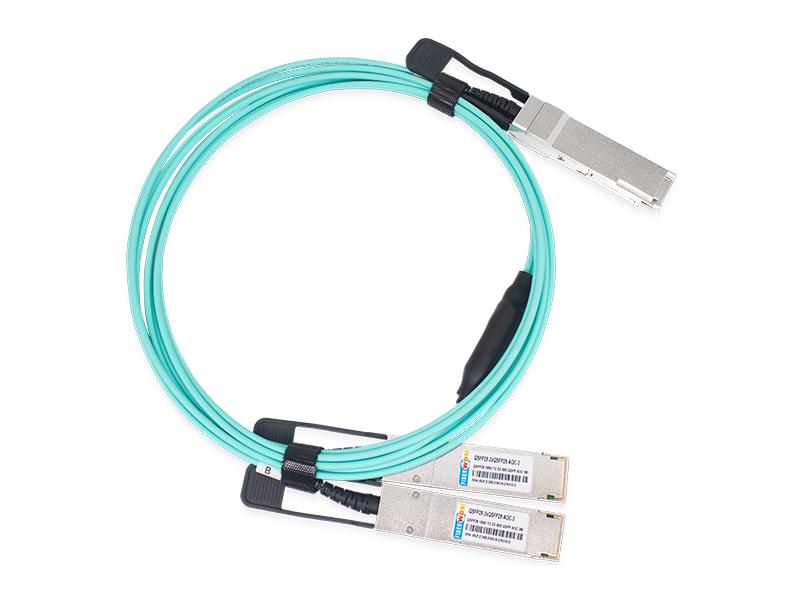Nei data center,
DAC (Direct Attach Copper) e AOC (Active Optical Cable)
sono due cavi di connettività ad alta velocità comunemente utilizzati. Possono sembrare simili nell'aspetto, ma differiscono significativamente in termini di funzionalità e scenari applicativi. Comprendere le differenze tra loro aiuta a fare scelte più appropriate durante la costruzione o l'aggiornamento dei data center.

Cos'è un cavo DAC?
Un cavo DAC è un cavo in rame con connettori standard (come SFP+, QSFP+) a entrambe le estremità. Trasmette segnali elettrici direttamente senza la necessità di moduli di conversione del segnale aggiuntivi.
Le sue caratteristiche sono evidenti: la distanza di trasmissione è breve: i DAC passivi raggiungono in genere solo 3-7 metri, mentre i DAC attivi raggiungono un massimo di 15 metri. Tuttavia, ha un costo contenuto e un basso consumo energetico: quelli passivi consumano pochissimo, mentre quelli attivi consumano meno di 1 W. Tuttavia, il materiale in rame lo rende suscettibile alle interferenze elettromagnetiche, rendendolo più adatto a scenari a breve distanza con ambienti elettromagnetici semplici.
Nei data center, i DAC sono comunemente utilizzati per le connessioni di dispositivi all'interno dello stesso rack (ad esempio, tra server e switch) o per interconnessioni a breve distanza tra rack adiacenti (entro 10 metri). Consentono trasmissioni ad alta velocità da 10 Gbps a 100 Gbps a un costo relativamente basso.
Che cos'è un cavo AOC?
Un cavo AOC è costituito da fibra ottica multimodale al suo interno, con transceiver ottici integrati a entrambe le estremità. Durante il funzionamento, i segnali elettrici vengono prima convertiti in segnali ottici per la trasmissione attraverso la fibra, quindi riconvertiti in segnali elettrici a destinazione.
Il suo vantaggio risiede nella trasmissione a lunga distanza: utilizzando la fibra OM3 si possono raggiungere i 100 metri, e alcuni prodotti superano addirittura i 300 metri. Inoltre, la fibra ottica è immune alle interferenze elettromagnetiche, garantendo un'elevata stabilità del segnale. Tuttavia, presenta costi e consumi energetici più elevati (circa 1-2 W) a causa della necessità di transceiver ottici per la conversione del segnale.
Gli AOC sono adatti per connessioni a lunga distanza nei data center, come interconnessioni tra dispositivi cross-rack o cross-floor, o scenari con requisiti estremamente elevati per la qualità del segnale, come l'elaborazione ad alte prestazioni e le transazioni finanziarie. Supportano trasmissioni ad alta velocità da 10 Gbps a 400 Gbps.
Differenze fondamentali e raccomandazioni per la selezione
Le principali differenze possono essere riassunte come segue: il DAC utilizza il rame per trasmettere segnali elettrici, garantendo distanze brevi, costi contenuti e minore suscettibilità alle interferenze; l'AOC utilizza la fibra ottica per trasmettere segnali ottici, garantendo lunghe distanze, capacità anti-interferenza e costi più elevati.
Nella scelta, considerate innanzitutto la distanza: date priorità al DAC per distanze entro i 10 metri, poiché è conveniente e sufficiente; scegliete AOC per distanze superiori ai 10 metri per garantire una trasmissione stabile. Inoltre, AOC è più affidabile in ambienti elettromagnetici complessi o in scenari che richiedono un'elevata larghezza di banda a lungo termine; il DAC è più economico per connessioni a breve distanza con budget limitati.
In conclusione, DAC e AOC hanno entrambi i loro punti di forza. I data center li utilizzano solitamente in combinazione in base a specifici requisiti di connessione per garantire efficienza e contenimento dei costi.
Con oltre 100 dispositivi di test dei prodotti, ogni cavo DAC e AOC da
Fibra WDM
Soddisfa rigorosi standard. Il nostro team di supporto tecnico dedicato si occupa di tutte le problematiche relative al prodotto, dal funzionamento alle sfide tecniche. Che abbiate bisogno di un DAC a corto raggio conveniente o di un AOC a lunga distanza ad alte prestazioni, Fiberwdm offre soluzioni su misura per migliorare la stabilità e l'efficienza del vostro data center.